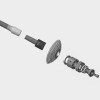Hip replacement rehabilitation
- Home
- Hip Surgery
- Hip replacement rehabilitation
Hip replacement (also called hip arthroplasty) is a very common surgical procedure in which the affected hip is replaced with an artificial joint (prosthesis) to help reduce pain and improve joint function.This intervention is not exclusive to the elderly. It is also performed in patients with other types of pathologies, for example, hip dysplasia in infants or femoral neck fracture due to accidents or neoplastic lesions.
GENERAL RECOMMENDATIONS
- Avoid antalgic postures, that is, avoid crossing your legs both lying down and sitting
- Avoid lying on the side of the fracture
- The use of cold compresses after performing an exercise session
- Use a booster seat, especially in the initial phase
- Make sure your wound is clean and dry, watch for the following signs of infection: warmth, redness, and swelling
- Watch your diet
PRE-OPERATIVE REHABILIľIľIľE IN HIP PROľESIS: PRACTICAL EXERCISES
The rehabilitation offered to patients undergoing this type of intervention has the objective of optimizing postoperative results. For this, it is advisable to start with preoperative physiotherapy in order to achieve clinical and functional improvement (pain relief, functional gait and independence for ADLs) and try to reduce possible post-surgical complications. Also including the work of muscular strength, balance and mobility.
POSTOPERATIVE CARE FOR HIP PROSTHESIS
Early mobilization after hip replacement surgery will form part of one of the key pieces in rehabilitation programs. In case of having carried out a preoperative treatment with the physiotherapist, after the surgery it will be time to put into practice everything previously worked on. Respiratory, isometric exercises and mobilizations in bed will be some that can be used immediately after the operation.
Physiotherapy will begin early with the care of the postures in bed, reducing the edema and treating the condition of the scar. In the same way, the patient will be provided with recommendations on how to avoid flexion movements greater than 90º, abduction greater than 30º-40º and not combine flexion or adduction with rotations. The operated leg must be outside the midline of the body, all this due to the risk of dislocation of the prosthesis.
In the first phase of rehabilitation, the physiotherapist will perform pain reduction techniques, circulatory and lymphatic drainage, scar massage, combined with kinesitherapy of the upper and lower limbs.
YOUR HEALTH FIRST

GEIS bone tumor meeting

Endo-exo integrated femoral prosthesis
CONSULT
Hospital Juaneda Miramar
Camí de la Vileta, 30
07011 Palma
971 280 000


